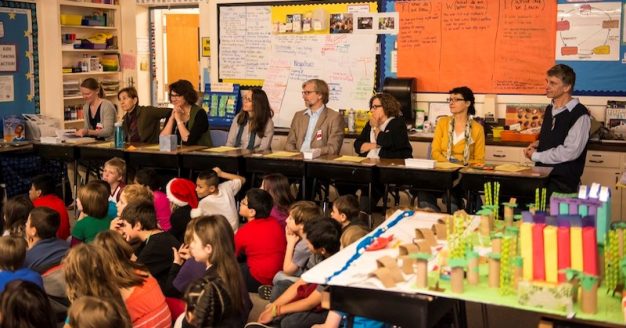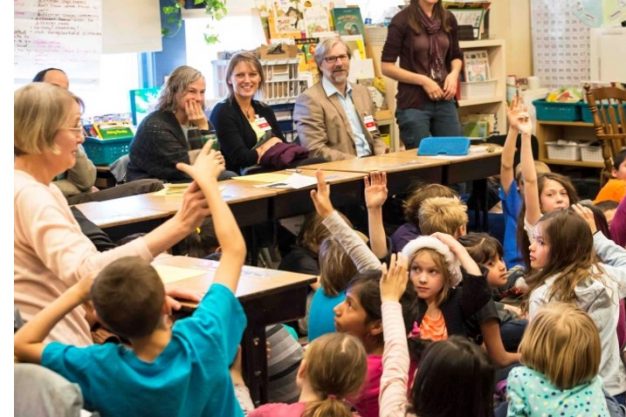
Assessing participatory processes for child-friendly cities
How do we know the effect of participatory processes on children? Growing Up Boulder has used an assessment tool to evaluate the impacts of facilitated participation on children’s perceptions of their community. The results make for interesting reading.
Community participatory assessment tool
The toolkit is adapted from the 2011 Children’s Environments Research Group’s Child-Friendly Cities and Communities Assessment Toolkit (IRC/CERG 2011). While the original intention of this tool was for children and young people to assess and prioritise issues in their communities, Growing Up Boulder has integrated some questions into a pre- and post-project assessment tool, to evaluate the impacts of participatory projects on children’s perceptions of their community. Such assessments have been used, for example, in a neighbourhood design project and in public space redesign projects, with children aged 8-16 (Derr and Kovács 2015, Derr and Tarantini 2016).
Specifically, Growing Up Boulder has asked children and young people three questions:
- ’I help with projects to change my community.’
- ’I am involved in planning or decisions for the community.’
- ’The government (city council, mayor, etc.) asks me my opinions about my life or my community.’
While younger children fairly consistently report increases in all three measures, we find more variation in how older youths respond to projects. For example, while all ages reported increases in feeling that they are involved in planning their community and that the government listens (Derr and Tarantini 2016), in a neighbourhood design project, we saw more variation in these measures.
The primary school students (ages 8-9) showed positive changes in all three measures, but the secondary school students (ages 14-15) showed significant gains only in “the government asks my opinions” question (Derr and Kovács 2015). Yet, we also sometimes see more significant gains among high school students (figure 1). In the neighbourhood design project, primary school students shifted from 40% not feeling heard by government prior to the project to only 15% after the project. But the secondary school students moved from 95% not feeling heard to 10%.
Children’s participation in design of their environment
One of the lessons we have learned is that direct connection with city leaders and planning staff can “make or break” whether young people feel heard. In a project for public space redesign, multiple classrooms participated in similar activities. Due to an illness, the city staff person did not visit one of the classes. While the students who did interact with city staff showed dramatic increases in feeling heard, the students who did not have such interactions showed no increase in this measure (Derr and Kovacs, 2015). While many factors may contribute to feeling heard, direct and meaningful connection to city staff is a critical component to inclusive planning processes.
Child-friendly cities provide an enabling framework for children’s participation in the planning and design of their environment. Children have been integrated into decision-making through a wide range of processes, from participatory planning and design to youth advisory boards (e.g., Blanchet-Cohen and Torres, 2015, Chawla, 2002, Cushing, 2015, Derr et al., 2013, Public Workshop, 2016). While the continued inclusion of children and youth is important, equally important is understanding the impacts that such work has on them. More development, testing and monitoring of tools in a wide range of projects would help us to better evaluate different approaches, and lead to greater progress towards the aim of creating ever more child-friendly cities.

Author: Victoria Derr
Photo Credits: Lynn M. Lickteig
Resources:
Blanchet-Cohen and Torres. 2015. Enhancing Citizen Engagement at the Municipal Level: Youth Perspectives. In J. Wyn and H. Cahill (Eds.), Handbook of Children and Youth Studies. Singapore: Springer Science+Business Media.
Chawla, Louise. 2002. Growing up in an Urbanizing World. New York: UNESCO/Earthscan Publications.
Cushing, D. F. 2015. Promoting youth participation in communities through youth master planning. Community Development, 46(1), 43-55.
Derr, V. and E. Tarantini. 2016. “Because We Are All People:” Outcomes and Reflections from Young People’s Participation in the Planning and Design of Child-Friendly Public Spaces. Local Environment: International Journal of Justice and Sustainability. http://dx.doi.org/10.1080/13549839.2016.1145643
Derr, V. and I. Kovács. 2015. How participatory processes impact children and contribute to planning: A case study of neighbourhood design from Boulder, Colorado, USA. Journal of Urbanism: International Research on Placemaking and Urban Sustainability. http://www.tandfonline.com/doi/full/10.1080/17549175.2015.1111925
Derr, V., L. Chawla, M. Mintzer, W. van Vliet. 2013. A City for all Citizens: Growing Up Boulder’s Approach to Engaging Children and Youth from Marginalized Populations. Buildings, Special Issue on Designing Spaces for City Living. Buildings 3, 482-505; doi: 10.3390/buildings3030482.
IRC/CERG. 2011. Child-Friendly Cities and Communities Assessment Toolkit. Accessed June 6, 2014. http://www.childwatch.uio.no/projects/activities/child-friendly-cities-and-communities-research-project/finaltoolkit2011.html
Public Workshop. 2016. Public Workshop: A Cheerleader of Possibility. Accessed March 5, 2016 from http://publicworkshop.us/about/



